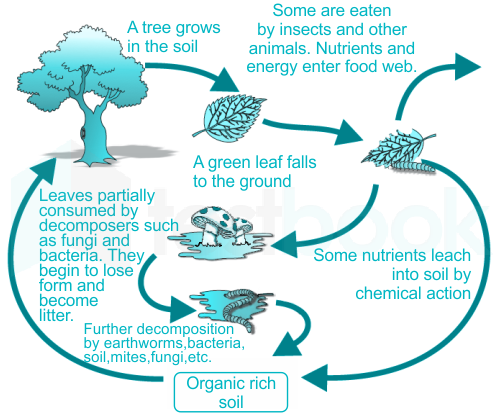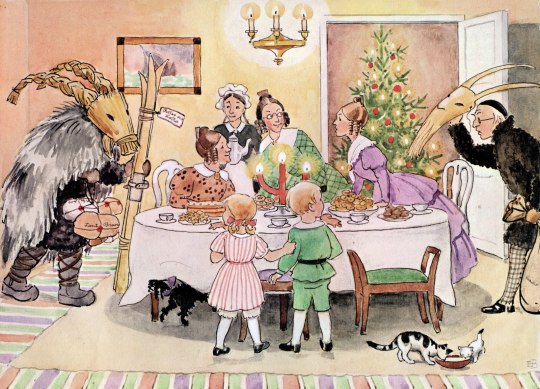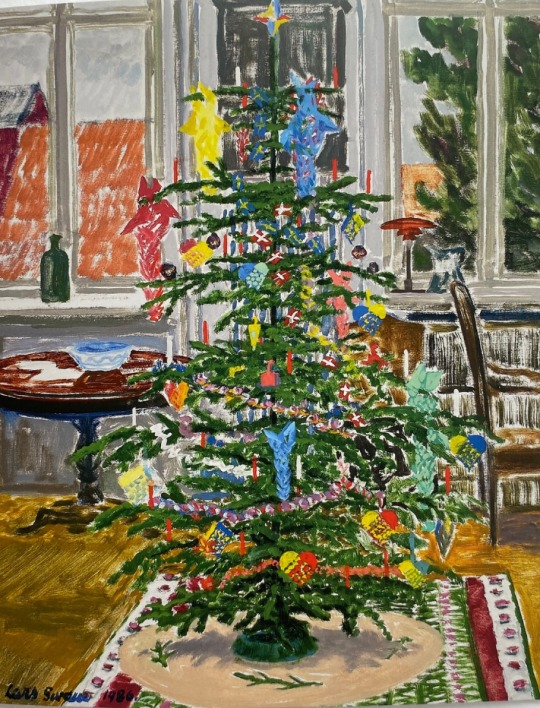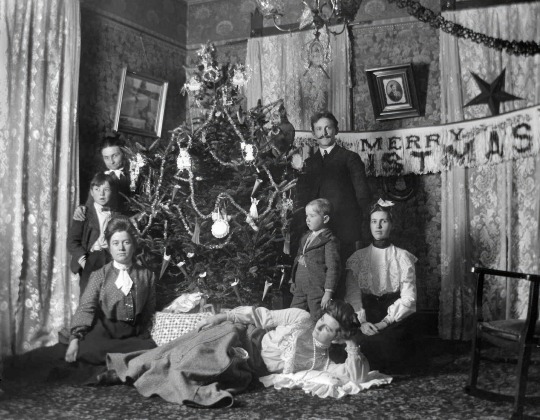#christmas traditions
Explore tagged Tumblr posts
Text
Something very strange happened, and I think we need to have a talk about the way some people who don't know about Catalan culture misrepresent the Tió (our pre-Christian Christmas present-bringer, a log who poops presents 🪵🎁).

I have a relative who is a teacher in an adult school, she teaches Catalan language (mostly to immigrants). Some days ago, they were doing an activity about Catalan holidays, and two of her students said that Tió should be banned and that it's the worst thing they have ever heard. My relative was very shocked and asked why they could say such a thing (imagine, it's like saying Santa Claus should be banned in the USA). Their reasoning was that they completely misunderstood everything about it. These people are native Spanish speakers and assumed that the Catalan word "tió" (meaning "log" 🪵) means the same as the Spanish word "tío" (meaning "uncle"), even though both words are pronounced differently. They believed that the Tió represents a man and that we tell children to beat people up, so much until they poop themselves, threatening them to give us things. They said it promotes violence to children and that it's disgusting. Nothing further from the truth.
This is not an isolated incident because a few days ago I saw a post on Tumblr repeating this same mistake. I texted the person who posted it saying that it's not called "Poop Uncle" but "Christmas Log" and they said that this was what they were taught by their teacher (this person is from a different continent), and haven't taken down the post. I have also seen comments on Instagram repeating the same and making fun of how gross and violent it is.
The real meaning of Tió
The Log is a way of symbolically passing down our relation with nature. This is how the tradition works:
In early December, we get a log and bring him home. We take care of him: we keep him in a warm place, with a blanket over him, and we feed him things like orange/clementine peels and walnut shells. On Christmas day, all the family comes together. Children get wooden sticks and go get ready in another room, meanwhile adults place presents under the Log's blanket. Children come back and hit the Log while singing a song. There are many local variants of the song but they all come down to asking the Log to poop us good food. When they have finished singing the song, the children remove the blanket and discover the presents that the Log has pooped. Years ago (now this is only done by some farmer families in rural areas, but back in the day this was generalized), the Log was burned in the house's fireplace and its ashes were spread on the fields, believed to act as a magical fertilizer.
Notice what this whole "ritual" has been about: we take care of nature, nature takes care of us, we are part of a whole and there's no real difference between "nature" and "us" because we all give life to each other. After the winter rest, we wake up nature (the Tió) so it will bring fruits and light again.
We take a log from the forest and bring it home. We do this for the Winter Solstice because it's the time of the return of light and the rebirth of nature after the winter sleep, and wood symbolizes the most important things for human life: food, warmth and light. It's difficult for us to imagine nowadays because we are used to electricity, but for our ancestors who only had oil lamps, fire and candles, darkness was almost absolute for many hours in winter, and that's why the Winter Solstice was very important because it meant that light is coming back. We want something from the Log, his fire will allow us to cook, it will give us light, and keep us warm. So we offer him the same: we feed him (notice what we feed it, too: a kind of compost, which is complimentary to human food), we keep him warm, and we love him. Then, we hit him with sticks (mimicking the motion of cutting down a tree) and ask him to give us food, and he does. Then, our ancestors used to burn him for warmth and light, and then take him back to plants spreading his ashes so it will give life to the fields. Which in turn will give us food again, which we will poop and it will fertilize plants again. And it's a cycle that never ends, we're all part of a whole.
We give to the forests, the forests can grow with the remains that all living creatures leave on its ground: leafs, excrements, the remains of parts of our food like nuts and fruit peels. These things give life to the forest. And the forest gives life to us: gives us fruits and wood (=light and warmth). We take these things, and in return we give to forests once again.

Nowadays, the part about warmth and light is often lost to kids, but the part about food is still obvious, even if subconsciously. This is why the Log is not the horrible barbaric tradition that the "haha poop and violence" crowd would make you believe.
And don't get me wrong, it can still be funny! We're the first ones to make jokes about it. And you can, too! But don't spread false ideas: the Spanish word "uncle" appears nowhere near this tradition because it doesn't have anything to do with uncles nor with Spanish-speaking cultures. It's called the Christmas Log (Tió de Nadal, Soca de Nadal, Tronca de Nadal, Tizón de Nadal, etc depending on the area, all meaning "Christmas Log") and it's celebrated by the Catalan people and a part of the Occitan and Pyrenean Aragonese people. The word "poop" (as an imperative verb, as in "please poop for us") appears in the song, but not in the name.
I know that, now that misinformation has gone viral, a post won't stop it. But I hope at least people with a genuine interest can learn some more. By all means, keep laughing! Make all the memes you want! But knowing the whole story will give you understanding. And, please, don't argue in favour of banning our cultural practises, we've had enough of that for centuries.
#tió de nadal#nadal#tradicions#catalunya#catalan culture#catalan#catalonia#coses de la terra#cultures#culture#anthropology#christmas traditions#christmas#folklore#folk culture
1K notes
·
View notes
Text

#mari lwyd#wales#welsh christmas figure#christmas#xmas#christmastime#december#winter folk characters#christmas folk traditions#christmas traditions
1K notes
·
View notes
Text
The Batfamily’s Christmas List Tradition (and how Tim gets lost in it)
The Batfamily has a long-standing Christmas tradition: the List. With so many members in the family, it’s a necessity. Everyone writes down what they want (within reason, of course), and the list serves as the ultimate gift guide. It’s efficient, especially for such a big family, and it ensures no one ends up with seven pairs of socks or the same gadget twice.
Tim takes the list seriously. It’s his chance to ask for the small, thoughtful things he wouldn’t usually splurge on for himself. Things like:
New makeup brushes. His old ones are worn out and falling apart, and it’s not until he’s on a mission that requires cross-dressing that he realizes just how bad they’ve gotten. Having a new, high-quality set would make everything feel a little smoother—and maybe even a little fun.
Cozy hoodies. Between Wayne Enterprises business casual and his Robin gear, Tim rarely gets the chance to wear something soft and comforting. His favorite hoodies are all fraying at the edges, with loose threads on the pockets and fabric that’s stretched too thin. A fresh one would feel like a luxury.
A new game console. Tim is rarely ever not working, but on those rare days off, he realizes he doesn't have much to entertain him that's not work related, that doesn't require him to leave his nest. Plus, it’s a great way to connect with his siblings during low-stakes, playful nights.
Nice coffee cups or tumblers. His caffeine habits are legendary, but the chipped and mismatched mugs he uses don’t exactly scream "Tim Drake." A sleek, stylish tumbler or a high-quality ceramic mug would elevate the most important part of his day.
Random indulgences. Books, stationery, weighted blankets, maybe a nice figuring from his favorite movie, a cool gadget he wouldn’t think to buy himself—little things that spark joy and make him feel cared for, anything he knows his own parents would have never bought for him to help heal his inner child. He's never had the luxury of writing such lists before becoming a Wayne.
Tim doesn’t just take the list seriously for himself; he makes sure to go the extra mile for his family, too. He’s always had a knack for gift-giving, and he loves curating the perfect presents for his siblings. For Dick, it might be a rare vinyl of his favorite band. For Jason, an antique first-edition book he’d mentioned once in passing. For Damian, something handmade and unique, like a custom leather-bound sketchbook or a rare art supply. Tim remembers the little things—the throwaway comments, the subtle preferences—and builds his gifts around them, ensuring every box under the tree feels deeply personal.
But Christmas rolls around… and none of the thought Tim puts into his gifts is reflected in what he receives.
Instead, he gets tech. More tech. External hard drives, cables, chargers—things he already has backups for because, well, he’s Tim. He doesn’t need more, and he didn’t ask for more.
And the worst part? It’s not that they’re bad gifts. It’s that the family assumes they know him so well that they don’t even look at his list.
“Tim’s the tech guy,” they think. “Of course he’d want more tech.”
But he doesn’t.
He’s grateful, of course—Tim is always grateful—but there’s a hollowness that creeps in every year when he unwraps another stack of USB drives and ethernet cables. It’s not about the gifts themselves. It’s about the realization that the people he loves, the people who should know him best, don’t see him the way he wants to be seen.
In a way, it feels painfully familiar. Janet had always made sure his presents as a child reflected her vision for him, not what he actually wanted. New tailored suits instead of the hoodies or tees he longed for. Sleek, professional office stationery to replace his Robin-themed pens and notebooks. Vintage collectibles meant to sit on a shelf, collecting dust, instead of toys he could actually play with. The gifts always came with a message: who he should be, not who he was. And now, even with the bats, the gifts still feel like expectations—like they see him as "the tech guy" rather than Tim, with all his quiet wants and overlooked needs.
So, Tim starts dreading Christmas. Not because he doesn’t love his family or the season, but because it reminds him of how little they seem to notice the little things about him.
And maybe one year, he stops adding personal things to the list altogether. Maybe he starts asking for tech, just to avoid the disappointment.
But deep down, he wishes someone—anyone—would surprise him with a new hoodie, a weighted blanket, or a set of makeup brushes. Something that says, “I see you, Tim. I really see you.”
#tim drake#batfam#christmas traditions#found family fails again#tim would be a thoughtful gift giver#tim gets them custom personal items and he gets cables and USB drives#how is that fair?
797 notes
·
View notes
Text
I feel like the Gävle goat being eaten by birds is its most suitable fate yet, because it brings back two old traditions.
One is the yule goat as a gift giver. This was common in the 19th century, but then Jultomten/Santa took over.
Here's a picture from Elsa Beskow's old picture book "Petter och Lottas jul", with a family being visited by two separate yule goats bearing gifts.

The other pertinent tradition is the raising of a "julkärve", Christmas sheaf, for the birds to eat. This is still done, but not at all to the extent that it was in the mid 20th century.
In Alf Prøysens picture book "Den vesle bygda som glømte at det var jul" (The village that forgot that it was Christmas), it is a sheaf that makes a little girl remember that it's Christmas, and she then raises the sheaf in the flagpole to remind the rest of the village.

Hence, it is as though the Gävle goat has resumed its old position as gift giver, and has turned itself into a gift of a Christmas sheaf for the birds.
...Which also sounds uncomfortable like High Mass, when I think of it...
2K notes
·
View notes
Text

Christmas Tree - Lars Swane, 1986.
Danish, 1913 - 2002
Oil on canvas , 15 x 19 cm.
2K notes
·
View notes
Text

#lifestyle#luxury#beauty#fashion#travel#christmas presents#christmas lights#christmas trees#christmas tree#christmas season#christmas time#christmas traditions#Christmas#christ
84 notes
·
View notes
Text

Frozen market built with notjackhd
#minecraft#minecraft build#minecraft art#minecraft house#minecraft project#minecraft builder#minecraft screenshots#art#project#minecraft house idea#christmas#christmas lights#merry christmas#xmas#holidays#christmas decorations#festive#christmas market#christmas traditions#christmas time#cracow#poland#krakow#old town#old town square#snowy old town#old building#architecture photography#buildings#streets
64 notes
·
View notes
Text
#Gävle Goat#sweden#Christmas#Christmas celebration#Gävle Goat 2024#burn baby burn#swedish yule goat#Arson#christmas traditions#christmas time#yule goat#yuletide#yule#poll#my polls#tumblr polls#polls#i love polls#gävlebocken#burn the goat
82 notes
·
View notes
Photo

The history of Christmas traditions kept evolving throughout the 19th century, when most of the familiar components of the modern Christmas including St. Nicholas, Santa Claus, and Christmas trees, became popular. The changes in how Christmas was celebrated were so profound that it's safe to say someone alive in 1800 would not even recognize the Christmas celebrations held in 1900.
Washington Irving and St. Nicholas
Early Dutch settlers of New York considered St. Nicholas to be their patron saint and practiced a yearly ritual of hanging stockings to receive presents on St. Nicholas Eve, in early December. Washington Irving, in his fanciful History of New York, mentioned that St. Nicholas had a wagon he could ride “over the tops of trees” when he brought “his yearly presents to children.”
The Dutch word “Sinterklaas” for St. Nicholas evolved into the English “Santa Claus,” thanks in part to a New York City printer, William Gilley, who published an anonymous poem referring to “Santeclaus” in a children’s book in 1821. The poem was also the first mention of a character based on St. Nicholas having a sleigh, in this case, pulled by a single reindeer.
Clement Clarke Moore and The Night Before Christmas
Perhaps the best-known poem in the English language is “A Visit from St. Nicholas,” or as it’s often called, “The Night Before Christmas.” Its author, Clement Clarke Moore, a professor who owned an estate on the west side of Manhattan, would have been quite familiar with the St. Nicholas traditions followed in early 19th century New York. The poem was first published, anonymously, in a newspaper in Troy, New York, on December 23, 1823.
Reading the poem today, one might assume that Moore simply portrayed the common traditions. Yet he actually did something quite radical by changing some of the traditions while also describing features that were entirely new.
For instance, the St. Nicholas gift giving would have taken place on December 5, the eve of St. Nicholas Day. Moore moved the events he describes to Christmas Eve. He also came up with the concept of “St. Nick” having eight reindeer, each of them with a distinctive name.
Charles Dickens and A Christmas Carol
The other great work of Christmas literature from the 19th century is A Christmas Carol by Charles Dickens. In writing the tale of Ebenezer Scrooge, Dickens wanted to comment on greed in Victorian Britain. He also made Christmas a more prominent holiday and permanently associated himself with Christmas celebrations.
Dickens was inspired to write his classic story after speaking to working people in the industrial city of Manchester, England, in early October 1843. He wrote A Christmas Carol quickly, and when it appeared in bookstores the week before Christmas 1843 it began to sell very well.
The book crossed the Atlantic and began to sell in America in time for Christmas 1844, and became extremely popular. When Dickens made his second trip to America in 1867 crowds clamored to hear him read from A Christmas Carol. His tale of Scrooge and the true meaning of Christmas had become an American favorite. The story has never been out of print, and Scrooge is one of the best-known characters in literature.
Santa Claus Drawn by Thomas Nast
The famed American cartoonist Thomas Nast is generally credited as having invented the modern depiction of Santa Claus. Nast, who had worked as a magazine illustrator and created campaign posters for Abraham Lincoln in 1860, was hired by Harper’s Weekly in 1862. For the Christmas season, he was assigned to draw the magazine’s cover, and legend has it that Lincoln himself requested a depiction of Santa Claus visiting Union troops.
The resulting cover, from Harper’s Weekly dated January 3, 1863, was a hit. It shows Santa Claus on his sleigh, which has arrived at a U.S. Army camp festooned with a “Welcome Santa Claus” sign.
Santa’s suit features the stars and stripes of the American flag, and he’s distributing Christmas packages to the soldiers. One soldier is holding up a new pair of socks, which might be a boring present today, but would have been a highly prized item in the Army of the Potomac.
Beneath Nast's illustration was the caption, “Santa Claus In Camp.” Appearing not long after the carnage at Antietam and Fredericksburg, the magazine cover is an apparent attempt to boost morale in a dark time.
The Santa Claus illustrations proved so popular that Thomas Nast kept drawing them every year for decades. He is also credited with creating the notion that Santa lived at the North Pole and kept a workshop manned by elves. The figure of Santa Claus endured, with the version drawn by Nast becoming the accepted standard version of the character. By the early 20th century the Nast-inspired version of Santa became a very common figure in advertising.
Prince Albert and Queen Victoria Made Christmas Trees Fashionable
The tradition of the Christmas tree came from Germany, and there are accounts of early 19th century Christmas trees in America, but the custom wasn’t widespread outside German communities.
The Christmas tree first gained popularity in British and American society thanks to the husband of Queen Victoria, the German-born Prince Albert. He installed a decorated Christmas tree at Windsor Castle in 1841, and woodcut illustrations of the Royal Family’s tree appeared in London magazines in 1848. Those illustrations, published in America a year later, created the fashionable impression of the Christmas tree in upper-class homes.
By the late 1850s reports of Christmas trees were appearing in American newspapers. And in the years following the Civil War ordinary American households celebrated the season by decorating a Christmas tree.
The first electric Christmas tree lights appeared in the 1880s, thanks to an associate of Thomas Edison, but were too costly for most households. Most people in the 1800s lit their Christmas trees with small candles.
The First White House Christmas Tree
The first Christmas tree in the White House was displayed in 1889, during the presidency of Benjamin Harrison. The Harrison family, including his young grandchildren, decorated the tree with toy soldiers and glass ornaments for their small family gathering.
There are some reports of president Franklin Pierce displaying a Christmas tree in the early 1850s. But the stories of a Pierce tree are vague and there doesn't seem to be contemporaneous mentions in newspapers of the time.
Benjamin Harrison's Christmas cheer was closely documented in newspaper accounts. An article on the front page of the New York Times on Christmas Day 1889 detailed the lavish presents he was going to give his grandchildren. And though Harrison was generally regarded as a fairly serious person, he vigorously embraced the Christmas spirit.
Not all subsequent presidents continued the tradition of having a Christmas tree in the White House. By the middle of the 20th century, White House Christmas trees became established. And over the years it has evolved into an elaborate and very public production.
The first National Christmas Tree was placed on The Ellipse, an area just south of the White House, in 1923, and the lighting of it was presided over by President Calvin Coolidge. The lighting of the National Christmas Tree has become quite a large annual event, typically presided over by the current president and members of the First Family.
Yes, Virginia, There Is a Santa Claus
In 1897 an eight-year-old girl in New York City wrote to a newspaper, the New York Sun, asking if her friends, who doubted the existence of Santa Claus, were right. An editor at the newspaper, Francis Pharcellus Church, responded by publishing, on September 21, 1897, an unsigned editorial. The response to the little girl has become the most famous newspaper editorial ever printed.
The second paragraph is often quoted:
"Yes, VIRGINIA, there is a Santa Claus. He exists as certainly as love and generosity and devotion exist, and you know that they abound and give to your life its highest beauty and joy. Alas! how dreary would be the world if there were no Santa Claus. It would be as dreary as if there were no VIRGINIAS."
Church’s eloquent editorial asserting the existence of Santa Claus seemed a fitting conclusion to a century that began with modest observances of St. Nicholas and ended with the foundations of the modern Christmas season firmly intact.
By the end of the 19th century, the essential components of a modern Christmas, from Santa to the story of Scrooge to strings of electric lights were firmly established in America.
Source
220 notes
·
View notes
Text
Homemade Hot Cocoa
This is the recipe my great grandma made and taught my grandma, who taught my mom and me. Every time we visited my grandparents or great grandma this cocoa was made for breakfast.
Ingredients:
1/2 cup of sugar
1/4 cup of cocoa powder
Dash of salt
1/3 cup hot water
4-6 cups milk
1 teaspoon vanilla
1/2 teaspoon burned sugar flavoring (optional)
Marshmallows
Directions:
In a large pot combine sugar, cocoa powder, salt and hot water. Mix until a paste forms.
Heat on low heat until the paste becomes a syrup, stirring often.
Slowly stir in milk and flavorings and continue to heat until desired temperature. DO NOT SCALD.
Add marshmallows and serve.
Notes:
I don't buy burned sugar flavoring, instead I heat the cocoa and sugar until it's sticky before adding water. This will cause the sugar to crystalize a bit when you add the water (even if it's boiling). Just keep stirring. Once you have a good syrup, add the milk as directed and keep stirring in any bits that may have stuck to the bottom or sides.
Just the sugar, cocoa powder, salt, and water makes homemade chocolate syrup! You can scale up the recipe if you'd like to keep some homemade chocolate syrup around for chocolate milk, ice cream, coffee, whatever you use it for.
If you have leftover, this makes the BEST chocolate milk I've ever had.
Feel free to customize if you like caramel, or mint, or any other kind of cocoa.
#recipes#recipe#hot cocoa#hot chocolate#from scratch#scratch cooking#homemade food#homemade#homemaking#homemaker#stay at home mom#housewife#tradwife#crunchy mom#hippie mom#traditional housewife#vintage housewife#50s housewife#traditional food#traditional homemaker#stay at home wife#home cooking#homecooking#christmas#dessert#warm drink#chocolate#christmas traditions#christmas time#winter time
48 notes
·
View notes
Text
In Catalan culture, some holidays are personified in a character. In Gràcia (a neighbourhood of Barcelona), Christmas starts with the arrival of Esperit de Nadal (Christmas Spirit) with his companions senyor Caneló d'Escudella i Bontorró ("Sir Escudella Cannelloni and Good-nougat", a parody of an artistocratic name referencing the traditional Catalan Christmas foods). Esperit de Nadal is a capgròs (big head figure, read more about them in this previous post).
They arrive at Gràcia and dance on the streets greeting the children, and at the end of the parade they do a dance that ends with removing Esperit de Nadal's hat, revealing a tiny Nativity scene on its head.
Video by Cultura Popular Barcelona.
#el senyor escudella etc etc té un aire al pere aragonès. just saying.#gràcia#barcelona#catalunya#capgrossos#nadal#christmas#folk culture#christmas spirit#tradicions#europe#folklore#christmas traditions
112 notes
·
View notes
Text

11 day until Christmas 🎄
#christmas countdown#christmas things#christmas theme#christmas tree#snowy pine trees#december snow#snow#christmas snow#christmas time#Christmas#christmas vibes#christmas cozy#cold weather#winter moodboard#winter cozy#winter vibes#christmas traditions#christmas town#not my image
35 notes
·
View notes
Text

Source: yatalaba_macarons on Instagram
#macaron#macarons#cookies#biscuits#sanrio#hellokitty#hello kitty#keroppi#mymelody#my melody#melody#cinnamoroll#christmas#christmasfood#christmas food#christmasart#christmas art#winter#december#merry christmas#holidays#holiday season#christmas tree#xmas#holiday#happy holidays#winter aesthetic#christmas aesthetic#christmas time#christmas traditions
35 notes
·
View notes
Text
As we approach Yule and the winter holidays, we see a LOT of false narratives around the origins of the ways in which they're celebrated. And not in the ways you think. This blog lays out sources intelligently and logically to illustrate the facts of our human history, not false sentiments of anti-Christianity/Pagan superiority.
I particularly appreciated this quote in their conclusion: "[I]t’s easy enough to show that the claims are wrong and then in turn that makes it look like Pagans and NeoPagans trade in propaganda, conspiracy theories, and uneducated claims - it makes all of us look bad. But to me, more importantly, when someone is starting out and wants to learn, misinformation builds walls, hurdles, and snares that they won’t know how to navigate at the start of their journey."
So before we go around teaching ourselves and others false information upon which to build our practices and worldviews, let's take the time to educate ourselves, yeah? I admit I have yet to get through *every* source listed in this blog as there are many (I am working on it, though!). I just believe this is vital information and have no desire to wait to share it.
Knowing what we celebrate, how we do it, and the why of it all is important, no matter the origins. Embracing our history and our modern practices need not be mutually exclusive. I hope this information strengthens and blesses your winter practices and celebrations this year. 🌟
#winter holidays#history#yule#jol#saturnalia#christmas#christmas trees#santa claus#sinterklaas#christmas traditions#holiday traditions#pagan traditions#religious history#religion#pagan#paganism#neopagan#neopaganism#historical accuracy#important#christianity#resources#academic research#academic#academia#informative#modern paganism#misinformation
47 notes
·
View notes
Text

Christmas Market at Kornhamstorg - Hilding Linnqvist , 1930s
Swedish, 1891-1984
Oil on canvas, 74 x 100.5 cm.
#Hilding Linnqvist#swedish artist#christmas traditions#christmas markt#Kornhamstorg#Grain Harbour Square#Old Town Stockholm#Stockholm#Sweden#study painting
68 notes
·
View notes